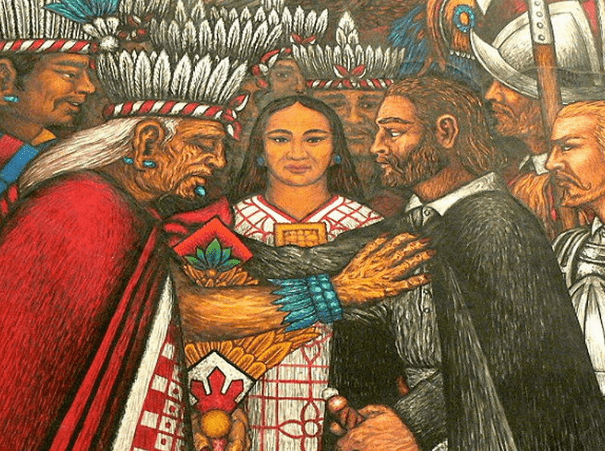Winner of the Fall 2016 StMU History Media Award for
Best Article in the Category of “People”
Best Article in the Category of “World History”
Largely due to the importation of disease and use of superior weapons, the Spaniards were able to conquer the Aztec capital of Tenochtitlan, kill the empire’s last emperor, Cuauhtémoc, and bring the Aztec empire to an end. Few know of La Malinche, the indigenous interpreter of Hernán Cortés, whose linguistic abilities were used to facilitate important conversations between the Spaniards and the indigenous leaders. Without the help of La Malinche, perhaps the Aztec empire would have survived.
Born between 1502 and 1505, La Malinche was named Malinalli Tenepal, the first part of her name being a Nahuatl term for the twelfth day of the month in correspondence to the Aztec calendar, and the second part of her name meaning “lively.” She was born of nobility in Paynala within the region of Veracruz. Her troubles started at a young age after the death of her father. La Malinche was ousted from her home to ensure her new half-brother received the inheritance of the family instead of her, since she was the eldest child. She was given to “some Indians of Xicalango.”1 Then the Indians gave her to a nobleman in Tobasco, a region in the Yucatan. When Cortés arrived to Tobasco, he was offered twenty slaves, one of them being La Malinche. Having lived in Veracruz, a Nahuatl-speaking region, and then being sold into a Maya-speaking region, La Malinche knew both languages and she was soon recognized for the linguistic talents that could benefit Cortés in his conquests.2

The few glimpses of La Malinche and how her presence as an interpreter accelerated the fall of the Aztec empire can be found in the writings of the Spanish explorers, specifically from Hernán Cortés, her “lord and master.”3 From the second letter Hernán Cortés wrote to Emperor Charles V, dated October 30, 1530, Cortés speaks of La Malinche as “a female interpreter that I had, who was a native of this country, and whom I obtained at Putunchún on the Rio Grande.”4 This confirms the vague aspects of her life that we already know. But most importantly, in this context, this letter goes on to tell of a scenario in which La Malinche saved the Spaniards from an ambush by the Cholulans. La Malinche was told by the wife of a native leader that they planned to attack the Spaniards and if La Malinche came with them, she would be protected. La Malinche delivered this message to Cortés, which ultimately led to the massacre of Cholula and provided a direct path to march towards Tenochitlan, the capital of the Aztec empire.5 This leads to the question of whether or not La Malinche was a traitor or a survivor. Did she explicitly want the Aztec empire to fall or did she just want to save herself from the carnage?
With no traces of primary sources from La Malinche herself, her story has been retold by various scholars without much consistency, nothing ever being certain. Up until the twentieth century, La Malinche was viewed as a traitor to her country Mexico. In 1861, on the celebration day of Mexico’s Independence, Ignacio “El Nigromante” Ramírez, a Mexican journalist, addressed the Mexican people by saying, “One of the mysteries of fate is that every Mexican owes his downfall and disgrace to a woman, and to another woman his salvation and glory; the myth of Eve and Mary is reproduced everywhere; we indignantly remember Cortés’s mistress and will never forget, in our gratitude to Doña María Josefa Ortiz.”6 La Malinche is seen as playing a key role in the subjugation of the Mexican peoples to Spain, while Doña María Josefa Ortiz did the contrary and liberated the country. However, many Chicana writers and modern scholars are trying to rewrite the tale of La Malinche to understand the complexities of her choices and to vindicate her. For example, Gloria Anzaldua promotes the idea that La Malinche had a “new consciousness,” that she voluntarily served as the interpreter of Cortés not only to save herself, but also because she knew that a new mestiza culture was going to be born (especially considering she had a son with Cortés in 1524).7 She made a conscious effort to exchange language and cultural aspects from each side in order to facilitate the emergence of the new mestiza society; however, with that came brutal consequences in the shape of warfare and mass death in the New World.
Whether or not La Malinche’s role as Cortés’s interpreter was traitorous, simply an effort to survive, or some other complex reason involving love for Cortés, hate for the Aztec empire for the cruelty she faced after being ousted from her home, or promotion of the new mestiza culture, no one will ever know the true story of the Indian, slave woman who traveled alongside Cortés towards the culmination of the Aztec empire.
- Bernal Castillo del Díaz, The Discovery and Conquest of Mexico, 1517-1521 rev. American ed., trans. A.P. Maudsley (New York: The Noonday Press, 1965), chap. 22-23. ↵
- Pilar Godayol, “Malintzin/ La Malinche/ Doña Marina: re-reading the myth of the treacherous translator,” Journal of Iberian and Latin American Studies 18, no. 1 (April 2012): 61-68. ↵
- Castillo del Bernal, chap 23. ↵
- Hernan Cortes to Emperor Charles V, October 30, 1520, in Letters of Despatches of Hernando Cortes, to the Emperor Charles V., trans. (New York: Wiley and Putnam, 1843), letter II. ↵
- Hernan Cortes to Emperor Charles V, October 30, 1520, in Letters of Despatches of Hernando Cortes, to the Emperor Charles V, letter II. ↵
- Rosario Pérez-Lagunes, “The Myth of La Malinche: From the Chronicles to Modern Mexican Theater” (PhD dis., Virginia Polytechnic Institute and State University, 2001), 24. Although she was of Spanish descent, Doña María Josefa Ortiz was born in Valladolid, Mexico in 1768 and identified herself as Mexican. She and her husband were both a part of the rebellion that ultimately led to Mexico’s independence from Spain in 1824. ↵
- Godayol, 68-70. ↵



230 comments
Ariette Aragon
First, congratulations on your award, you did a very good job! Since I read the title, I was intrigued and wanted to know more about this woman called La Malinche and what she did to be called these to words. Very interesting how the fate of the Aztec Empire was in her hands, I can’t imagine what went through La Malinche’s mind in that moment. In my opinion, she did what she did to survive and honor her master, and maybe also because she resented her own people because of what they did to her. Finally, I would like to add that the pictures and footnote you used really caught my attention and were really good.
Samuel Vega
The title of the article lures you in to consider two perspectives: survivor or traitor. This is a good technique to capture the attention of the reader. The article explains both perspectives and gives you current information on how writers and scholars are starting the conversation on how La Malinche deserves another look in history. Mariana, congratulations on your two recognitions for the History awards. I know the competition was tough. Well Deserved!
Phylisha Liscano
Hello Marina, I wanted to start off by congratulating you on your award for “Best Article in the Category of People” and “Best Article in the category of World History”. Before now I had never heard of La Malinche or the story behind her. It was a great idea to give us a little glimpse of what we were about to read. Throughout the article, there were lots of facts that kept me entertained. It was very interesting learning about how people view La Malinche as a traitor or as someone who was wanting to survive, or even as someone who was hurt by her past. Taking a look at your works cited I can tell you had done lots of research. The images you provided allowed me to visualize more of the story. In one of the illustrations, I enjoyed getting to see the differences between the clothes of the Spaniards and the clothes of the Nahuatl-speaking people.
Edgar Cruz
In terms of the Historical context, I believe that this article discusses the alleged facts in a very proper and non-bias manner. The events of La Malinche’s story are clear and descriptive. Despite the modern-day explanations given after the story, itself, the story fits very well into a variety of Historical themes such as: Conflict and the development and Interaction of Cultures. I greatly appreciate that you used a very important primary source such as a letter from Cortes himself. I also found the introduction very compelling and eye-opening as to the advantage the Spaniards had. The picture, along with the foot note, was very insightful as to the importance translators, like La Malinche, had in the conquest of Mexico. Overall, I found this article very interesting and important because without this very important story, Mestizos, like myself (the mix between Spaniards and Native Americans) couldn’t have been as possible.
Santiago Sabogal
I personally find this article very informative. I didn’t know about the existence of “La Malinche” and her crucial role in the defeat of the Aztec empire executed by the Spaniards, led by Hernan Cortes. I think that the author did a great job writing this article with an impartial point of view on whether she was a traitor or not. Also, the author did a great rat job with the research and the use of pertinent sources and information. Finally, in my opinion, La Malinche was not a traitor, but rather she was just an slave of Cortes trying to survive.
Sabrina Drouin
First off, congrats on winning those two awards, this is truly an amazing and interesting article! I love how the title itself is a question, this really made me hooked into the story from the very beginning. I have never heard this story before, but I think that since she was ousted from her family so the fortune would go to her younger brother, she had some resentment for the Aztec Empire and ultimately didn’t mind if the empire fell. In addition to that, I believe that she was probably completely in love with her captor, almost like stockholm syndrome, to the point where she would do anything for Cortes, like warn him of attacks from the Cholulans.
Aidan Farrell
This was a very well done and frankly interesting passage. I had no idea that La Malinche existed, but reading this passage definitely made me want to learn more about her. You included really good information that seemed to be relevant and integral to this woman’s story. If there was anything I had to say about your passage, it could have been longer. it was a pretty short read. Otherwise, well done.
Perla Ramirez
I have never heard of the Malinche before so this is the first time I am hearing about her and the impacts she had on the Spaniards trying to conquer the Aztec capital of Tenochtitlan. Also her linguistic abilities allowed her to communicate with the Spaniards and the indigenous leaders which would benefit Cortes and his conquest. But in the end she wasn’t labeled a hero. She was labeled either a traitor or a survivor, even after what she had done for them was not respected.
Martha Nava
Congratulations on your awards Mariana! Prior to this reading I had no idea who La Malinche was, now I have learned that she is held responsible (by many) for enabling the colonization of America. I really like the cover photo you chose as well; it gives a clear visual at how she was the “middle-girl” for their communication needs. Personally, I think the conquistadores’ weapons were too much for the Aztecs which is why Hernán Cortés still defeated the Aztecs, even if he was warned or not. However, I truly wonder that if that were to be Hernán’s last day, after the ambush attack, how perhaps history would be different.
Eliana Villarreal
This article was a great viewpoint into the life of La Malinche! I had previously and briefly learned about La Malinche in a former Mexican-American studies class but this provides even more insight into the life she lived as Cortes’s slave. I can’t imagine the tough decisions she had to make in order to survive. I can see why she would be a traitor and a survivor of her efforts but in the end, she was a brave woman. Congratulations Mariana on a job well done with your article!